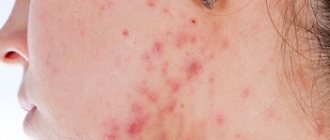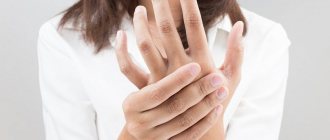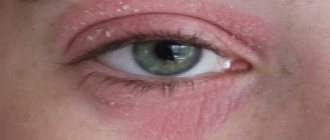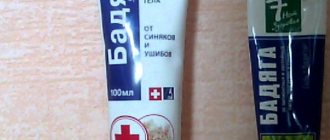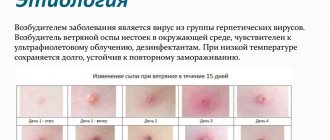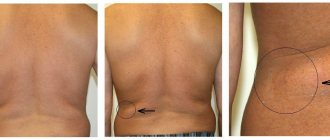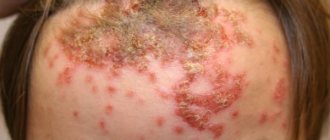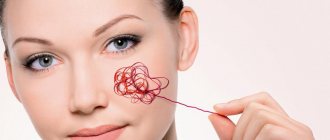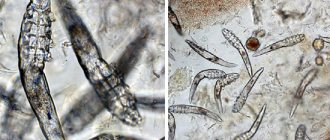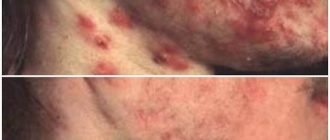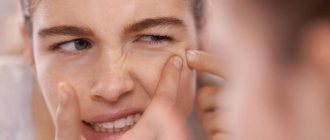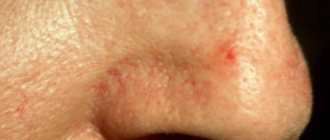Welcome to the pages of a medical blog designed to help everyone. On the current agenda is such a problem as dermatitis. Let's figure out where it comes from and how to treat dermatitis on the face of an adult, and most importantly, what standards to adhere to so as not to encounter this problem again.
It's no secret that some diseases that were rare twenty or thirty years ago have now become commonplace.
Human skin is a kind of barometer of the body, which means that it often signals us about various kinds of internal problems and problems. One of the most widespread skin diseases today is dermatitis.
Dermatitis - what is it?
Dermatitis is an inflammatory disease of the skin. In the vast majority of cases, dermatitis, one way or another, affects the surface of the skin on the face, causing not only physical inconvenience, but also directly bringing with it psychological problems.
Just half a century ago, skin dermatitis was considered the province of children, but now this disease often affects adults as well.
The main reasons for the development of pathology
There are many factors that significantly contribute to the development of this disease. The main ones among them are the following:
- Allergic reaction.
- Exposure to aggressive chemicals.
- Mechanical effect on the skin.
- Fungal and bacterial microflora.
- Excessive insolation or pronounced influence of low temperature.
- Severe psycho-emotional stress.
Constant stressful situations are one of the predisposing factors for the development of dermatitis
On a note. Identifying the specific cause of facial dermatitis is extremely important. This is due to the fact that it will depend on exactly what medications should be used for therapy.
Dermatitis in adults
More and more often, nowadays, adults - men and women - turn to dermatologists for help due to the appearance of unpleasant rashes on the skin of the face, due to irritation and itching.
Among the reasons, experts increasingly see the irritating effects of modern cosmetics and household chemicals, allergies to various substances, including sometimes medications.
Many skin diseases clearly manifest themselves in adulthood. But there are some exceptions. So, for example, atopic dermatitis begins in childhood as a diathesis to certain products, accompanying a person throughout his life.
It is noteworthy that in adults, dermatitis differs in the nature of its course. There are also some differences here based on the type and variety of dermatitis; we’ll talk about this in more detail below.
Dermatitis in adults - stages of the disease:
- The acute period is the formation of swelling and red spots, the appearance of blisters filled with an unpleasant serous fluid. This period is often accompanied by an unpleasant burning sensation on the face and intense heat.
- The subacute period is the time when scales and scabs form on the skin, causing a lot of trouble for the patient due to severe itching and general anxiety.
- The chronic period is the time when dermatitis reaches a stage that is difficult to treat. The disease at this time manifests itself seasonally and recurrently.
Treatment
Dermatitis is primarily treated symptomatically (treatment aimed at eliminating symptoms). To eliminate inflammation and itching, ointments “D-Panthenol”, “Akriderm” and “Bepanten” are mainly used. The latter is also recommended for children under one year of age.
Most of these ointments simply stimulate intercellular metabolic processes and take part in the absorption of provitamin B5. It, in turn, contains pantothenic acid, which accelerates skin regeneration and helps restore collagen bonds. Based on this, you need to understand that ointments are a symptomatic treatment. If we are talking about the treatment of an allergic form of dermatitis, then inflammation will soon reappear.
Use of antihistamines
Inflammation caused by an allergic reaction occurs after a sharp increase in histamines in the blood. In fact, it is these substances that contribute to the very abnormal reaction of the body to an external stimulus. Antihistamines, accordingly, regulate the release of histamines, thereby inhibiting the development of dermatitis.
Such drugs include “Cetrin”, “Aleron”, previously they used “Diazolin” (an antihistamine of the old generation). For children under one year old, such tablets are not prescribed - mothers take them instead (if they are breastfeeding). Later, the active substances in acceptable concentrations enter the baby’s body along with breast milk.
Antihistamines are not effective against dermatitis that does not occur as a result of an allergic reaction. In addition, they have many side effects and contraindications. Therefore, they are prescribed after the exact cause of skin inflammation has been established.
Corticosteroid drugs
Corticosteroid drugs (mainly in the form of ointments) can also be used to eliminate inflammation. These include “Hydrocortisone”, “Prednisolone” and their derivatives.
How do they work? Corticosteroids suppress the synthesis of prostaglandins, which cause inflammation of soft tissues. At the same time, metabolic processes in the upper layers of the skin are normalized and swelling is eliminated. But again, this is symptomatic treatment.
It is worth noting that corticosteroid drugs have the ability to accumulate in the body, which gives them a prolonged effect against dermatitis. That is, using the ointment only 1-2 times, the effect will persist for several days until the concentration of corticosteroids decreases. This time should be enough for doctors to make a final diagnosis.
Prescribing antibiotics
Antibiotics in the treatment of dermatitis are used exclusively in cases where the inflammation is caused by a pathogenic infection. Most often, its role is played by staphylococci, which affect the sebaceous glands and hair follicles. Antibiotics can be prescribed both in the form of injections and tablets and ointments. The most effective in this regard are Doxycycline, Erythromycin (ointment for external use), and Tetracycline (in the form of injections and ointments).
Long-term use of antibiotics in the treatment of inflammation of an infectious nature is strictly prohibited. The maximum permissible period is 1 week, after which the patient is recommended to take general strengthening agents (vitamins, biologically active food supplements) and immunomodulators of a general complex.
Hardware treatment and traditional medicine
Hardware treatment of dermatitis is used mainly for atopic and contact forms. The primary cause of inflammation will be a local decrease in immunity on the skin of the face. Such therapy includes, for example, ultraviolet exposure to the epithelium and mechanical cleaning of the stratum corneum. Seborrheic dermatitis is treated in a similar way, but in this case pulsed electricity is used. That is, the skin is precisely exposed to a low-voltage, but high-frequency electric current. This stimulates the optimization of blood flow and restores metabolic processes in cells. Often in this way it is possible to get rid of not only seborrheic dermatitis, but also alopecia (if they are combined).
Traditional medicine in the treatment of dermatitis can offer a huge number of tips, but the most effective and popular in this regard are compresses made from chamomile decoction. This procedure eliminates inflammation quite well, including in atopic dermatitis. An important point is that this remedy can be prescribed even to small children up to 3 months old.
Types of dermatitis on the face in adults
In addition to general risk factors, there are also narrowly targeted causes that become the causes of various types of disease. This disease is a real Serpent-Gorynych with different dangerous types.
NOTE!
To quickly get rid of blackheads, acne and pimples, as well as to rejuvenate your facial skin, we recommend that you familiarize yourself with this effective remedy .
Find out more...
There are different types of dermatitis, each with its own symptoms, specific treatment and complexity of its course.
Allergic dermatitis
From the name itself it is clear: who is to blame for the disease. We are talking about the body's individual reaction to a specific allergen or irritant.
In this case, many things can act as an allergen: plant pollen, dust, animal hair, various food products, cosmetics and household chemicals. Dermatitis manifests itself in varying degrees: areas of rash, slight redness, runny nose, swelling and lacrimation.
The allergen itself is not terrible - it is too small. However, once in the bloodstream it quickly binds to blood proteins. It is this compound that acts as a provocateur of the disease. The main signs of the disease show themselves 5-6 days after contact with the allergen itself.
In order to get rid of such dermatitis, you need to find the irritant and remove it. However, this must be done from the first stages of the disease. This type of dermatitis quickly develops into complicated forms.
Rapid deterioration in health, appearance of scars on the face and severe headaches. Over time, the disease develops into a more serious atopic form.
Atopic dermatitis
Often, incorrectly or not treated at all, allergic dermatitis leads to a new stage - atopic dermatitis. This type of disease manifests itself as itchy and unpleasant, rather bright red spots on the face, which can be weeping crusts.
We are talking about eczema - a disease that is dangerous due to its fairly rapid transition to the chronic stage.
This type of dermatitis is characterized by an allergic basis; heredity often plays a large role in its appearance. This disease can peacefully sleep in the body for decades, suddenly awakening under the influence of certain factors.
In this case, the trigger can be, for example, a nervous shock, a hormonal surge, or improper skin care. This type of disease is considered the most widespread.
Contact dermatitis
This type of disease is very similar to allergic. The only difference is that only areas of the skin that came into contact with the allergen are susceptible to such inflammation. We are talking about clothing, cosmetics, household items (for example, a latex pillow), jewelry (containing nickel), medications, and unsuitable care products.
This dermatitis is characterized by a long period of manifestation. Only after a couple of weeks a person can detect the first signs of the disease on the face. This type also includes sun allergy (photodermatitis).
This type of disease is the easiest to treat and most often goes away without consequences. However, if you ignore the situation, the disease can lead to complications. On the face, simple redness over time may well develop into unpleasant itchy blisters and peeling.
Oral dermatitis
Oral (rosacea-like) often affects adults aged 20-30 years. The disease manifests itself in the form of rashes in the area around the mouth, sometimes spreading to the skin of the eyelids and bridge of the nose. It is easy to recognize by its spots ranging from pink to bright red. Such spots often change color (depending on weather conditions).
The culprits of this disease are long-term use of external products (cosmetics, toothpaste, cream, ointments, lipstick). A stimulating factor is a metabolic disorder, nervous and digestive system, as well as the intake of hormonal substances.
Treatment of this type of dermatitis is not so difficult if the disease is mild. In this case, you need to carefully monitor your face and become more demanding in choosing care products.
If you do not focus on painless spots, then you soon run the risk of noticing not the most beautiful and sometimes even lumpy thickenings on them.
Seborrheic dermatitis
Often this disease is simply called “salt discharge.” The culprit of the disease is the saprophytic flora that exists in each of us. It suddenly begins to spread in large numbers.
At the same time, the products of her life activities quickly change the chemical composition of the secretion of the sebaceous glands, which acts as a provocateur for the onset of the disease.
And, of course, nothing happens for nothing - everything happens for a reason. The impetus for the development of this type of disease is the human immune system, which clearly fails. And here it is customary to distinguish between two types of illness:
- Dry - the skin is very flaky, the face is quickly covered with whitish itchy scales, which are difficult to get rid of.
- Oily – the skin becomes covered with a pustular rash (acne or black comedones). The face quickly takes on a grayish and slightly shiny color.
This type of dermatitis can affect an adult of any age. And here an attentive approach and comprehensive, competent treatment are important.
Kinds
The following types of dermatoses on the face are distinguished depending on the symptoms and causes of their occurrence.
- Itchy
One of the most unpleasant skin diseases is itchy dermatoses, which begin as local rashes and then grow to cover almost the entire face. They get wet, become covered with crusts, and thickening of the skin appears in the affected area. Characterized by severe itching. This includes eczema, polymorphic dermatoses, and neurodermatitis.
- Bubble
Blistering dermatoses look very unsightly on the face, the cause of which lies in a weak immune system. The affected area is covered with blisters with various fillings: blood, mucous, purulent. This is where another name for this group of diseases comes from - bullous dermatoses (bull - bubble). This includes infectious rashes such as herpes and impetigo, as well as a number of autoimmune diseases (Dühring's dermatosis, blistering dermatosis).
- Allergic
Most often, allergic dermatosis is diagnosed, which occurs after direct contact with an irritant. A distinctive feature is the variety of symptoms: blisters, ulcers, swelling, rashes, and hyperemia can form on the face. This group includes skin diseases such as contact dermatitis, dermatozoonosis, and toxidermia.
- Mental
Recently, more and more often doctors are being treated with dermatoses on the face caused by mental disorders. Due to prolonged tension, a rash appears on the skin. This includes dermatozoal delirium, eczema, and neurodermatitis.
- Viral
One of the largest groups is viral dermatoses, which include warts, condylomas, molluscum contagiosum, herpes, and lichen.
- Seborrheic
If the cause of the skin disease is a malfunction of the sebaceous glands, seborrheic dermatosis is diagnosed, which manifests itself in the form of a large number of acne, comedones, a gray complexion, shiny skin, peeling and itching.
- Pigment
If lentigo, chloasma, nevi appear on the face in huge quantities, and even begin to grow, this is pigmentary dermatosis, which may not be harmful, but can lead to skin cancer. There are also more dangerous forms of such diseases - for example, Schamberg's disease, which requires long-term treatment.
If the cause of a skin disease on the face is an insect bite, after a series of therapeutic and preventive measures there is no trace left of it. But if the body reacts in this way from the inside to some irritants, this is a chronic dermatosis, which some people have to put up with all their lives. The only thing they can do is regularly engage in preventive measures to avoid exacerbations of the disease.
Helpful advice. If you notice that you have spots or rashes of unknown origin on your face that do not go away, do not try to self-medicate. If you have dermatoses, you should definitely consult a doctor to avoid further complications.
Dermatitis - causes of pathology
What are the hidden causes of such an unpleasant illness? Why do the exocrine glands simply stop functioning normally at some point?
Key risk factors are poor heredity, poor lifestyle and nutrition. Hormonal imbalances, the use of low-quality cosmetics, stress, constant fatigue, bad habits - all this quickly attracts dermatitis to itself like a magnet.
The reasons can be both internal and external:
- Disorder of the exocrine glands.
- Use of low-quality care products and cosmetics.
- Genetic predisposition.
- Disorders of the digestive and hormonal system.
- Bad habits.
- Insufficient oxygen supply.
- Sedentary lifestyle.
- Poor nutrition.
- Prolonged stress.
- Emotional stress.
- Neuroses and depression.
- Chronic fatigue.
In the case of poor nutrition, lifestyle, frequent stress, and the use of inappropriate cosmetics, dermatitis appears on the face.
In order to prevent the development of the disease, doctors advise adhering to preventive measures: treating existing diseases in a timely manner, leading a correct lifestyle, and paying attention to sports.
There are certain irritants that cause the formation of common dermatitis:
- temperature regime;
- pressure and friction;
- acids and alkalis;
- ionizing radiation;
- some plants.
Causes
Dermatosis on the face does not appear on its own. It arises under the influence of one, but very powerful factor, or several at once. The causes of skin diseases are usually divided into two groups.
External factors (exogenous)
- Physical: injuries to the face due to shock, heat, cold, ultraviolet radiation, electric current;
- chemical: the effect of concentrated acids or alkalis on facial skin;
- infectious: penetration into the layers of the epidermis of pathogenic organisms - viruses, fungi, bacteria;
- biological: insect bites (mosquitoes, midges, flies).
Internal factors (endogenous)
- Any diseases: connective tissue pathologies, chronic tonsillitis, tuberculosis;
- impaired metabolism, unhealthy diet: lack of substances in the body such as carbohydrates, vitamins, proteins, fats;
- hypersensitivity to allergens: a sharp reaction to irritants, which may be foods or medications;
- improper functioning of the endocrine and nervous systems;
- heredity.
Since there are a lot of skin diseases, in medicine there is a classification of facial dermatoses (and more than one) depending on the causes of their occurrence and symptoms.
Keep in mind! Many dermatologists believe that nervous system disorders are the underlying internal cause of nearly half of skin diseases. Therefore, they recommend that their patients, first of all, worry less and avoid stressful situations.
Diagnosis of dermatitis
In case of the first signs of itching and rashes - key signs of dermatitis, it is important to immediately contact an allergist or dermatologist. For the most part, these experts conduct the examination, so to speak, together.
In individual situations, a diagnosis can be made and the cause established based on the results of a survey and initial examination. And yet, more often you have to be patient and pass the required list of tests.
A clinical blood test will make it possible to assess the level of inflammation activity, and a biochemical analysis will show changes in the activity of internal organs, which may be the cause of dermatitis.
If an allergic origin of the disease is suspected, the specialist will prescribe a blood test for immunoglobulin E and carry out the required allergy tests.
To comprehensively exclude dermatitis caused by food, there are studies that determine the body’s increased sensitivity (sensitization) to certain foods in the blood and skin using the scarification method.
If allergic contact dermatitis is suspected, skin testing with a range of allergens should be performed. In addition to the allergist and dermatologist, consultation with other experts is often required: gastroenterologist, endocrinologist, neuropsychiatrist, and so on.
Treatment of any facial dermatitis begins with a visit to a specialist - a dermatologist. It is the doctor who will help you timely establish the true causes of the formation of the disease, give useful advice, tell you how to cure facial dermatitis, and create a personal treatment regimen.
Dermatitis - folk remedies
Treatment of facial dermatitis with the help of folk remedies is most often aimed at actually muting the symptoms. There are many variations that complement the prescriptions of doctors in complex and most advanced forms of the disease, or will help to get rid of the problem once and for all from the first stages.
- Ointments
Homemade ointment is particularly effective. In addition to the antiallergic creams recommended by experts, you can also make an ointment at home, which will certainly help reduce itching and reduce inflammation.
- Tar. Take a tube of shaving cream and mix it with tar (6 grams), heat it to a temperature of +60° C. Apply the cream to the affected areas two to three times a day.
- Lactic-glycerin. Mix milk (15 grams) with glycerin (16 ml). After this, add rice starch in volume to the mixture to thicken the mixture. Apply the mixture in the evenings and leave it on your face overnight.
- Potato. Grate the potatoes (100 grams) on a fine grater and add liquid honey (7 ml). Apply the ointment to your face overnight.
- Herbal decoctions and tinctures
Treatment of dermatitis using herbs is considered effective. It is worth making healing mixtures in advance. Store such decoctions in a cool place, but no more than 3 days. We wipe the skin with herbs two to three times a day. The course is one month.
- Walnut decoction. Grind seven walnut leaves, add a glass of water, put on low heat and boil for 6 minutes. Let the jar of broth sit for two hours.
- Wine tincture. Grind four plantain leaves, add a third of a glass of white wine. Infuse the mixture for several hours.
- Intoxicating tincture. Mix the string and hops (10 grams each) with boiling water (150 ml). Let it sit for 40 minutes.
It is beneficial to consume celery juice 30 minutes before meals 3 times a day. Pass the celery root through a meat grinder and squeeze out all the juice from the resulting mixture. We take 15 ml.
- Vegetable and essential oils
An excellent remedy for combating dermatitis is a mixture of different oils. They effectively relieve itching and irritation and soften the skin. We apply healing agents to all problem areas two to three times a day.
- Take baby cream with anti-allergenic ingredients (10 grams) and add myrrh and cypress essential oils (2 drops each).
- Mix cosmetic oils of wheat germ and jojoba (17 grams), St. John's wort or amaranth (34 grams). We also add 3 drops of orange essential oil (or rose, fir, sandalwood, patchouli, tea tree or rosemary).
- Take milk (16 ml), add essential oils of cedar and geranium (5 drops each), mint (3 drops).
In undiluted form, essential oils help: tamanu, black currant, almond and sea buckthorn oils, jojoba and macadamia oils, jojoba, as well as apricot and chamomile oils, geranium and cedar, ylang-ylang and leuzea, frankincense and lavender. It is customary to apply them pointwise to the affected areas 2-3 times a day.
Treatment process
There are many ways to treat dermatitis on the face. The choice of a specific technique will entirely depend on what exactly caused the development of the pathology. The main means to combat it are the following:
- antihistamines;
- non-steroidal anti-inflammatory drugs;
- glucocorticosteroids;
- antibacterial and antifungal drugs;
- diet therapy.
In addition, with this disease, you will definitely have to slightly adjust your lifestyle.
For dermatitis, it is often necessary to use drugs from several pharmacological groups at once
Antihistamines
Such drugs are used very often to treat dermatitis on the face. Treatment of this pathology with antihistamines is often started earlier than with medications from other pharmacological groups. Moreover, they often begin to take them even before consulting a dermatovenerologist. Most often, patients use the following drugs from this group:
- "Fenkarol".
- "Suprastin".
- "Loratadine."
- "Clemastine."
- "Cetirizine."
The basis of their action is blocking reactions involving histamine. This helps reduce swelling and severity of the inflammatory process . For this pathology, these drugs can be used in different forms. The most commonly used are tablets. They are recommended to be taken 1-2 times a day for 5-7 days. Antihistamine ointments for dermatitis on the face are very popular. They are usually prescribed to be used 2 times a day. In this case, the drug is applied directly to the affected areas of the skin.
Note. In more severe cases, when it is not possible to reduce swelling and severity of the inflammatory process with the help of tablets and ointments, injectable forms of drugs can be used.
In this situation, Clemastine is most often prescribed. It is administered intramuscularly in a volume of 1-2 ml. Usually, a few days after such treatment, skin dermatitis on the face goes away.
Allergic dermatitis on the face is one of the most common forms of the disease.
Nonsteroidal anti-inflammatory drugs
Medicines from this group are also quite often used in the treatment of this disease, regardless of the cause of dermatitis on the face. Currently, the following medications of this type are most often used:
- "Ketorolac".
- "Nimesulide".
- "Diclofenac".
- Meloxicam.
They provide an excellent anti-inflammatory effect. In addition, they significantly reduce the level of swelling and pain in the affected area. Treatment of dermatitis on the face with ointments and creams made on the basis of non-steroidal anti-inflammatory drugs is very effective and popular. Moreover, their use, like antihistamines, often begins even before contacting a dermatovenerologist.
Important! It is not recommended to take tableted drugs from the group of non-steroidal anti-inflammatory drugs in large dosages on your own, as they negatively affect the gastric mucosa. Uncontrolled use of such medications can lead to the development of not only gastritis, but also ulcers.
NSAIDs are very often used in the form of various ointments
Drugs from the group of non-steroidal anti-inflammatory drugs for dermatitis on the face in injection form are prescribed extremely rarely. Under no circumstances should you use such medications on your own, as there are many contraindications to their use.
Glucocorticosteroid drugs
Many patients do not know how to treat dermatitis on the face in an adult if medications from the group of antihistamines and non-steroidal anti-inflammatory drugs do not help. Currently, glucocorticosteroid medications are very often prescribed in this case. They are not recommended for children. The most commonly used drugs from this pharmacological group are:
- "Hydrocortisone."
- "Prednisolone."
- "Methylprednisolone."
Such drugs have powerful anti-inflammatory and desensitizing properties. In addition, they are able to relieve swelling and reduce the severity of an allergic reaction. They are most often used in the form of ointments. In this form, such drugs have fewer side effects . The most common is hydrocortisone ointment.
Hydrocortisone ointment is one of the most effective and frequently used remedies for severe dermatitis on the face
As for tablets and injections, they are used very rarely for dermatitis. This is due to the fact that when using them, various side effects can develop, for example, a significant increase in blood pressure.
Note. Glucocorticosteroid drugs (due to the possible development of serious side effects) for dermatitis can only be prescribed in fairly short courses.
Antibacterial and antifungal medications
Sometimes the cause of dermatitis on the face is the activity of bacterial or fungal microorganisms.
In this case, to more effectively combat the disease, it is necessary to use agents that can suppress it. We are talking about antibacterial and antifungal drugs. Without these medications, the disease can progress and become chronic. The main medications with antibacterial properties and used for dermatitis are the following:
- "Amoxicillin."
- "Cefalexin".
- "Erythromycin".
All of them are prescribed in tablet form. If they fail, the doctor prescribes more serious medications to the patient. For example, Azithromycin or Augmentin. If treatment with these drugs is unsuccessful, a scraping is performed from the area of the affected skin, followed by determination of the sensitivity of the microflora to certain antibiotics. In case of particularly serious manifestations of dermatitis on the face, it is necessary to use injectable antibacterial drugs.
Pathogenic microflora quite often causes the development of dermatitis on the face or complicates their course
As for antimycotic drugs, they are used for dermatitis on the face in cases where it is caused by the activity of fungal microorganisms. The main drugs from this pharmacological group are:
- "Nystatin"
- "Clotrimazole".
- "Miconazole".
- "Itraconazole"
- "Fluconazole".
They can be used both in the form of tablets and in the form of ointments.
Note. Only a doctor can determine the presence of fungal microorganisms using special research methods, so you should not use antifungals without a prescription.
Injectable forms of drugs are used for dermatitis only in the most severe cases
Diet therapy
Treatment of dermatitis on the face includes not only the use of various medications. Following a special diet is very important. The main task is to exclude all allergenic foods from the diet. The patient should not use the following:
- Citrus fruits and any exotic fruits.
- Seafood.
- Honey.
- Whole milk.
- Berries.
- Smoked meats.
- Seasonings.
Until the dermatitis goes away, it is recommended to limit yourself to green apples, cereals, potatoes and boiled chicken breast. Naturally, a hypoallergenic diet alone is not enough, but it will reduce the rate of spread of the disease.
If you have dermatitis, you should be especially wary of citrus fruits, as they have pronounced allergenic properties.
Note. Recommendations for dietary therapy should be provided by the attending physician.
Dermatitis - prevention and prognosis
Most often, facial dermatitis does not have the best prognosis. However, if you go to the hospital in a timely manner, recovery is often possible. Nevertheless, it is important to always remember: having suffered from dermatitis at least once, you need to once and for all eliminate contact with the irritant that caused the pathology.
In the absence of proper therapy, the disease can become chronic, making it difficult to respond to treatment itself. In such a situation, pathology will remind itself from time to time.
Often a person in such a situation develops eczema, wet ulcers appear, and peeling of the skin does not give rest. Modern medicine has created many variations in the treatment of this disease.
To prevent the disease, you need to adhere to the rules of hygiene, as well as monitor the condition of the skin on your face, use hypoallergenic products and creams. In addition, you should exclude from your diet foods that promote the production of subcutaneous fat.
Strengthening the immune system, as well as timely treatment of diseases and normalization of digestion, including chronic ones, will help to avoid pathology.
Only if you follow all the advice can you actually avoid the development of the disease. In addition, you should not rely on self-medication, because dermatitis is a serious disease that requires a special approach in terms of treatment. Only timely contact with a dermatologist really reduces the risk of complications and unpleasant consequences.
